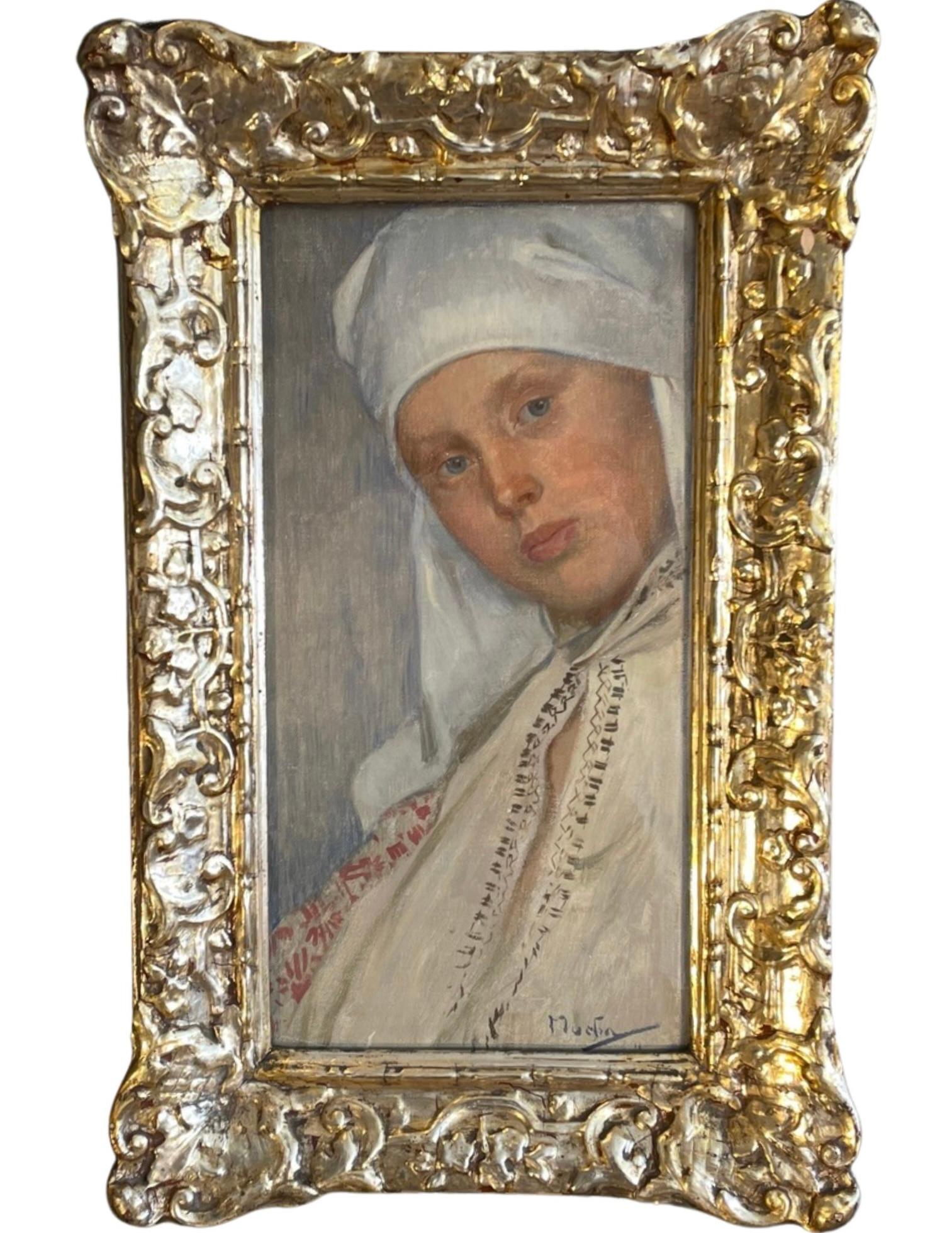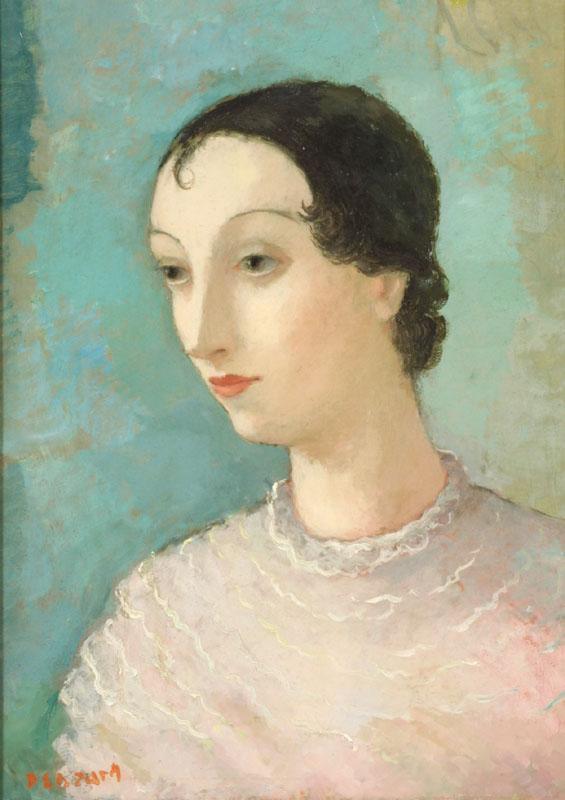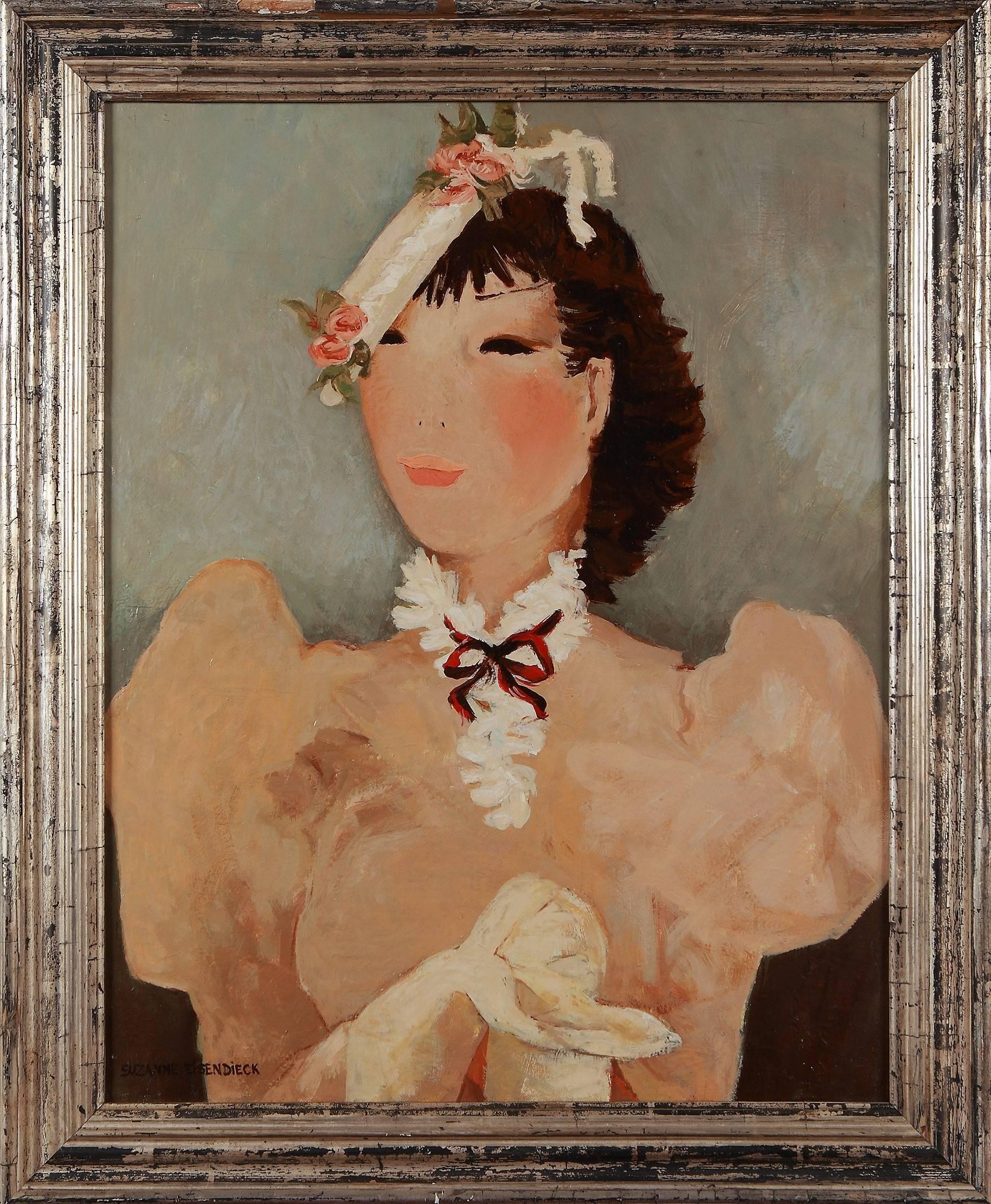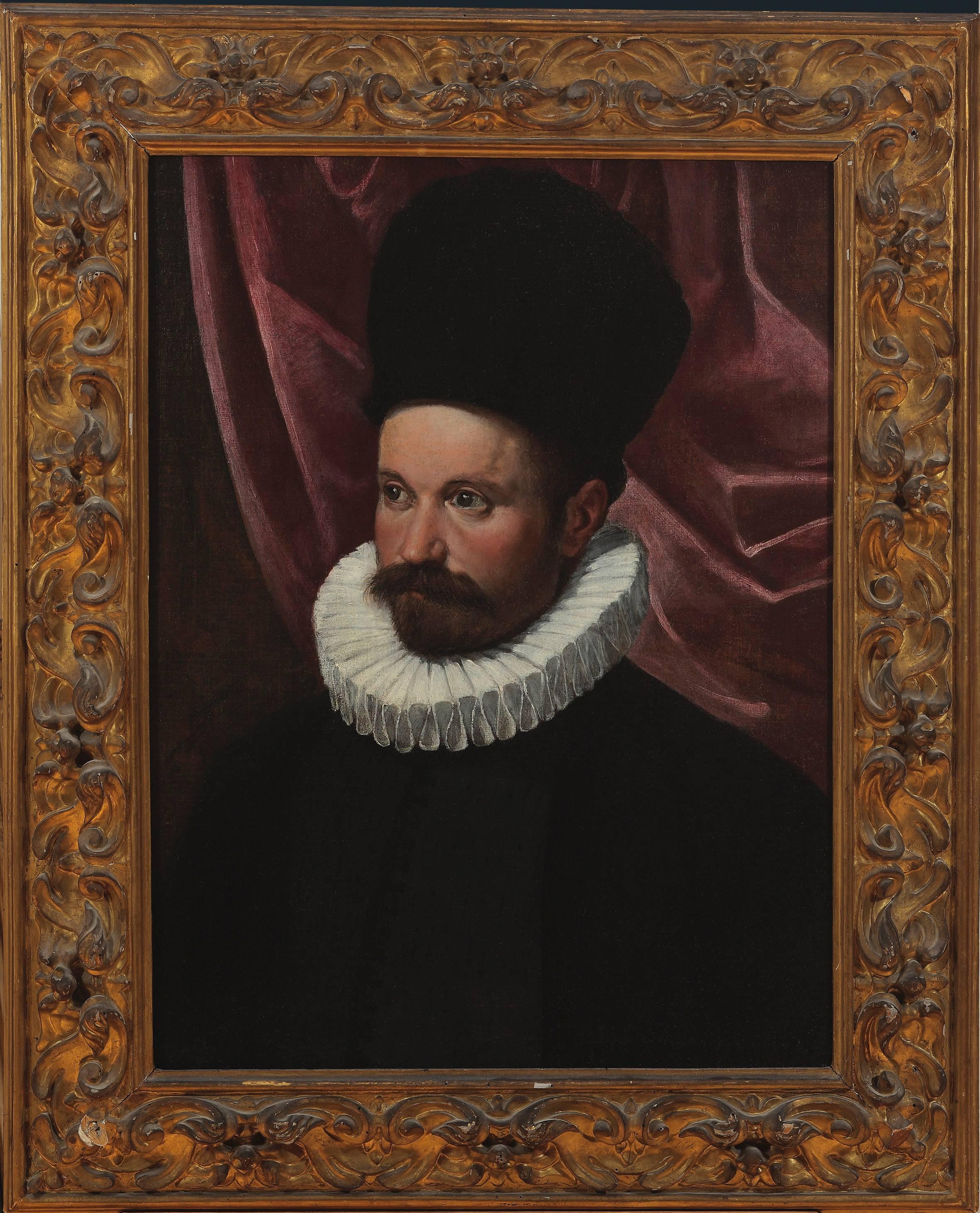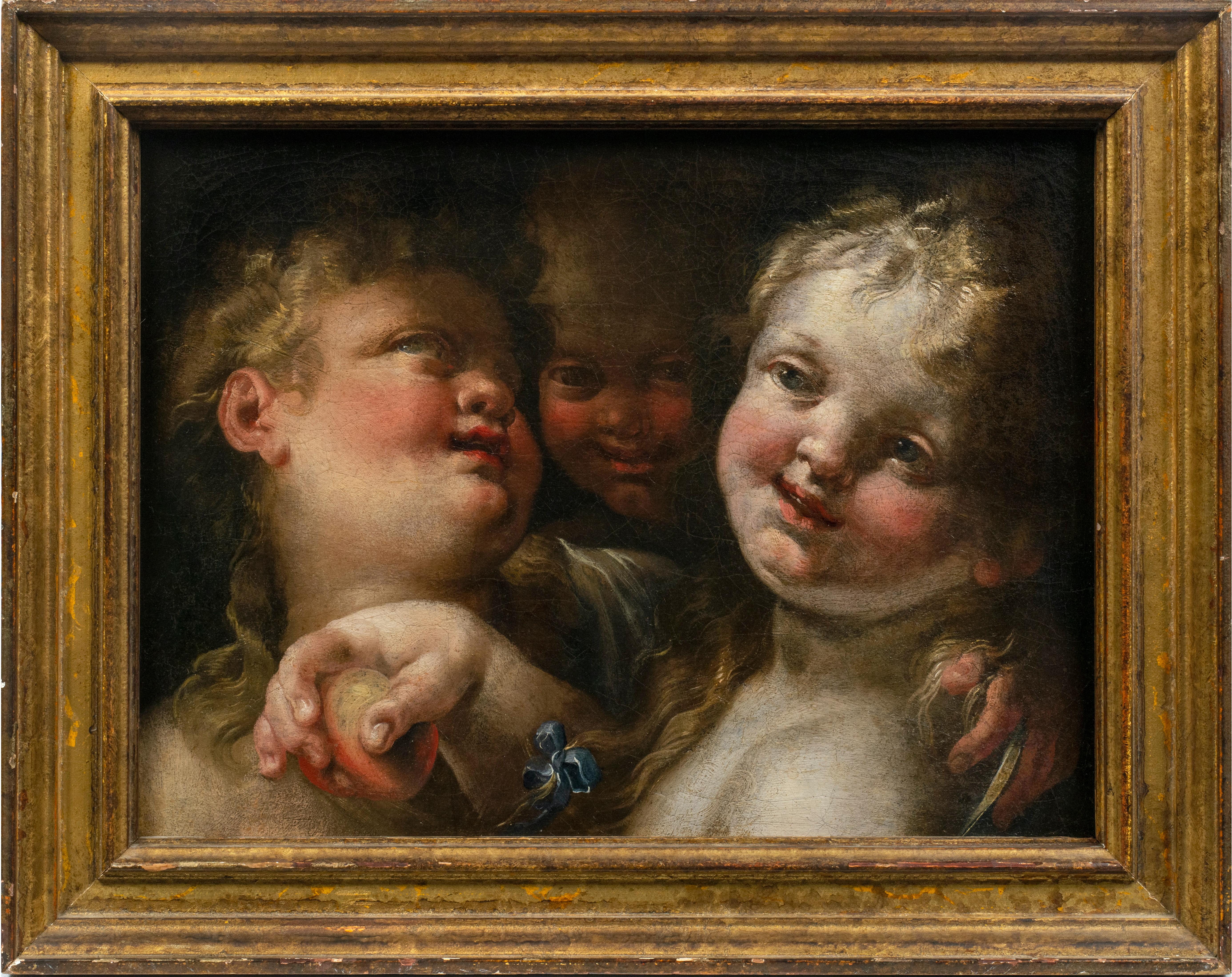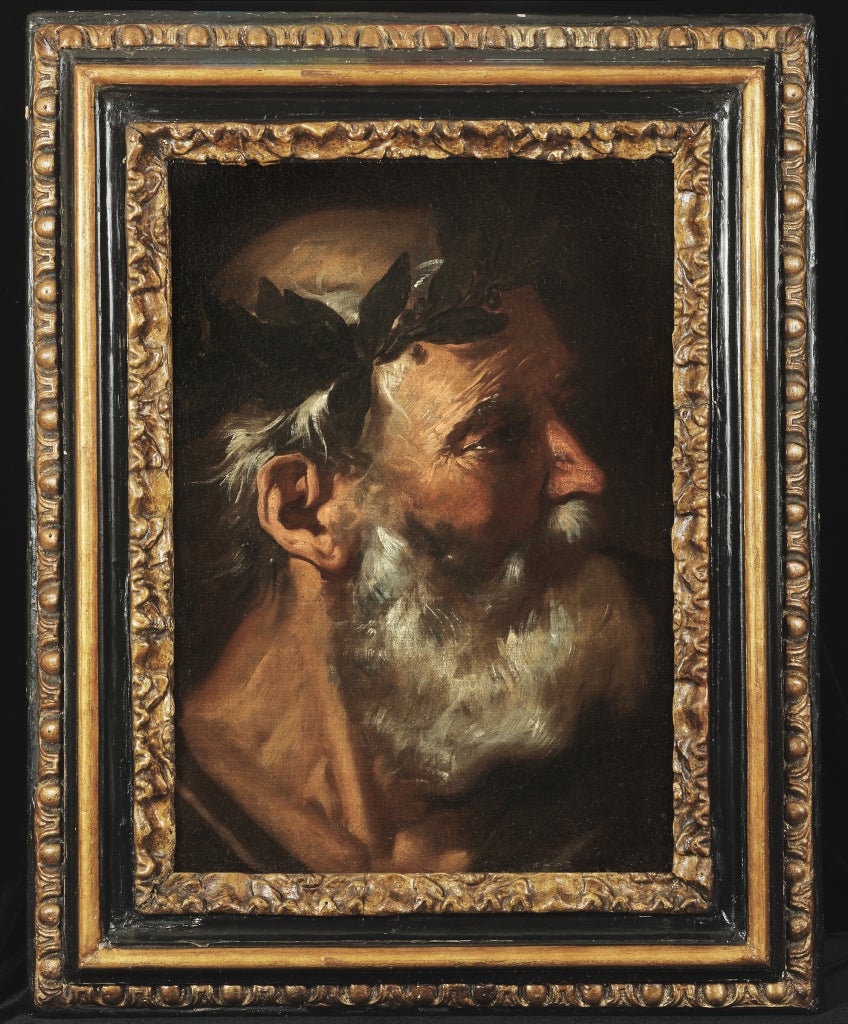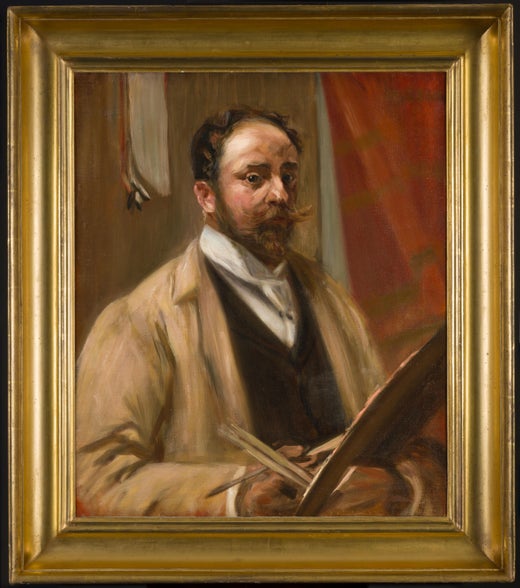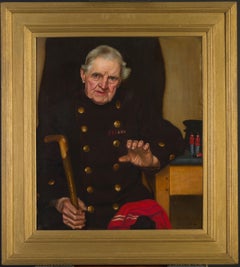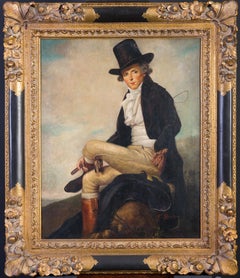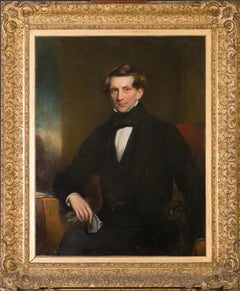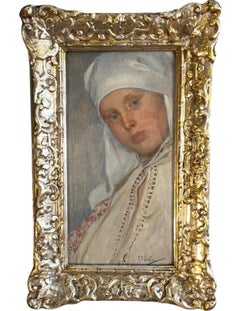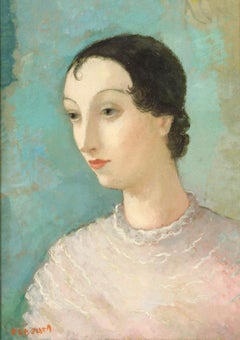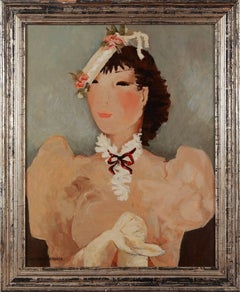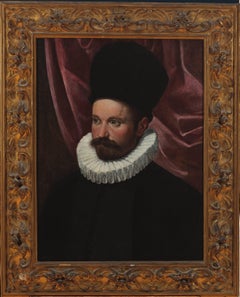Items Similar to William Merritt Chase
Want more images or videos?
Request additional images or videos from the seller
1 of 12
Walter ShirlawWilliam Merritt ChaseEarly 20th Century
Early 20th Century
About the Item
Walter Shirlaw 1838-1909, was a Scottish born American painter who lived in America from the age of two years old. Shirlaw studied in Munich where he befriended American painters Frank Duveneck and William Merritt Chase. Shirlaw exhibited in Philadelphia, Paris, Munich and retrospectively in Pittsburg. Shirlaw was regarded as one of the most important painters of his day in America. His works are held in some of the grandest museums and private collections throughout America. This work was painted by Shirlaw almost certainly from his memorable days with Chase as I believe it was painted around the turn of the 20th Century as his health probably determined the decision to paint this portrait with the knowledge of his impending demise. This painting shows Merritt Chase in his distinguished pose well known by Shirlaw for many years. This is a rare portrait from one popular artist of another. Both painters were responsible for the establishment of the Society of American Painters and they worked together teaching the next generation of popular students who were to become well known artists in their right.
- Creator:Walter Shirlaw (1838-1909, American)
- Creation Year:Early 20th Century
- Dimensions:Height: 30 in (76.2 cm)Width: 25 in (63.5 cm)Depth: 1 in (2.54 cm)
- Medium:
- Period:
- Condition:
- Gallery Location:Douglas, GB
- Reference Number:Seller: No. 257.1stDibs: LU2373215744602
Walter Shirlaw
Walter Shirlaw, born in 1838, was only three when he came to Hoboken, New Jersey from Paisley, Scotland. As a young man, he found work as a bank note engraver, a profession that he continued in Chicago, where he lived between 1865 and 1870. But already in 1861 he was exhibiting genre paintings at the National Academy of Design. In 1868, Shirlaw was a member of the Chicago Academy of Design, which would become the Art Institute of Chicago, after changing its name from the Chicago Academy of Fine Arts. Shirlaw spent the years 1870-77 in Munich, at the height of the movement led by Wilhelm Leibl in which a low-keyed, dark palette, combined with bold, virtuoso brushwork, were applied to realist subject matter. Michael Quick defined the time of Shirlaw's arrival as an especially experimental period in progressive German painting. Shirlaw's teachers, however, sided with tradition. The genre painter Arthur Ramberg and Wilhelm von Lindenschmidt, his successor at the Munich Academy, taught Shirlaw composition. The painter of genre scenes and landscapes, Alexander von Wagner was Shirlaw's teacher in painting. T. H. Bartlett mentioned that Shirlaw regarded Leibl as too realistic. In 1877, the second school year of the Art Students League, Lemuel E. Wilmarth announced that he would be returning to teach at the NAD. Frank Waller took over as president of the ASL, and Shirlaw was hired to teach painting and drawing. The appointment was endorsed by Waller. The hiring of Shirlaw and William Merritt Chase seemed to signify a preference of Munich over Paris among the members of the Art Students League, however, while Chase was under Leibl's spell, Shirlaw was strictly academic. During the fourth season at the ASL, Shirlaw taught composition. Thomas Wilmer Dewing replaced Shirlaw in this position in 1880. Although an Associate of the National Academy of Design, Shirlaw resigned, explaining that the Academy was too much focused on exhibitions, at the expense of teaching. He turned to the Society of American Artists, a more liberal group founded in June of 1877. Shirlaw himself, Augustus Saint-Gaudens, and Wyatt Eaton were the artists-founders of the SAA. Within a year, there were twenty-two members. This new, mostly younger group of painters collectively expressed more liberal aesthetic tastes, compared to the less progressive members of the National Academy. Doll and Richards Gallery in Boston was the setting for Shirlaw's one-man exhibition in 1880. Meanwhile, he was active as an illustrator. The artist published drawings in Scribner's Monthly and Harper's Magazine, and did illustrations for various books. In 1889, Shirlaw visited Crow and Cheyenne reservations to illustrate scenes from the life of these tribes. He was also a muralist and a designer of stained-glass windows. He executed Sciences, a mural for the Library of Congress. Walter Shirlaw was an American artist who helped the younger painters promote French impressionism, by founding the Society of American Artists.
About the Seller
5.0
Vetted Professional Seller
Every seller passes strict standards for authenticity and reliability
1stDibs seller since 2023
15 sales on 1stDibs
Typical response time: 2 hours
- ShippingRetrieving quote...Shipping from: Douglas, United Kingdom
- Return Policy
Authenticity Guarantee
In the unlikely event there’s an issue with an item’s authenticity, contact us within 1 year for a full refund. DetailsMoney-Back Guarantee
If your item is not as described, is damaged in transit, or does not arrive, contact us within 7 days for a full refund. Details24-Hour Cancellation
You have a 24-hour grace period in which to reconsider your purchase, with no questions asked.Vetted Professional Sellers
Our world-class sellers must adhere to strict standards for service and quality, maintaining the integrity of our listings.Price-Match Guarantee
If you find that a seller listed the same item for a lower price elsewhere, we’ll match it.Trusted Global Delivery
Our best-in-class carrier network provides specialized shipping options worldwide, including custom delivery.More From This Seller
View AllThe Spanish Beauty
Located in Douglas, Isle of Man
John Philip 1817 -1857, was a Scottish painter born into a poor impoverished background but was identified for his artistic abilities and sponsored by Lord Panmure the Earl of Dalhou...
Category
Mid-19th Century Portrait Paintings
Materials
Canvas, Oil
The Chelsea Pensioner
Located in Douglas, Isle of Man
Anne Marjorie Robinson 1858 - 1924, was a British painter in oil and watercolour of portraits and miniatures. Annie as she was sometimes known was born in Belfast Northern Ireland an...
Category
1890s Portrait Paintings
Materials
Canvas, Oil
Portrait of Pierre Seriziat
Located in Douglas, Isle of Man
Copy of a Portrait of Pierre Seriziat by Jacques Louis David which was painted in 1795 , David 1748-1825, this picture is a direct copy by an artist by the name of F. Hamilton. There...
Category
Late 20th Century Portrait Paintings
Materials
Canvas, Oil, C Print
Henry Wyndham Phillips
By Thomas Phillips
Located in Douglas, Isle of Man
Thomas Phillips R.A. 1770-1845, was an English portrait painter and he painted many of the greatest people of the day including , artists, poets, writers, scientists and many other p...
Category
Mid-19th Century Portrait Paintings
Materials
Canvas, Oil
Portrait of Molly Le Bas
Located in Douglas, Isle of Man
Edward Le Bas 1904-1966, was an English painter and art collector. He was born in London to a wealthy family his father was a steel magnate, Edward had 2 sisters, twins, Molly and Gw...
Category
1940s Portrait Paintings
Materials
Canvas, Oil
3rd Countess of Dysart, Grace Wilbraham
By Sir Godfrey Kneller
Located in Douglas, Isle of Man
Sir Godfrey Kneller 1646-1723, was a German born British portrait painter. He was born in Leiden and studied under Bol and Rembrandt, before travelling to Rome, Venice, Hamburg and ...
Category
Late 18th Century Portrait Paintings
Materials
Canvas, Oil
You May Also Like
'Obraz-Divka' (The Girl) by Alphonse Mucha - Original Mucha Portrait Painting
By Alphonse Mucha
Located in Carmel, CA
The American Art Gallery takes immense pride in offering "The Girl - A Study for the Slav Epic," an authentic original work by the celebrated Art Nouveau icon, Alphonse Mucha. Dating...
Category
1910s Art Nouveau Portrait Paintings
Materials
Canvas, Oil
Oil on Canvas "L' Espagnole" by Dietz Edzard, 1935
By Dietz Edzard
Located in Berlin, DE
Dietz Edzard ( German/French 1893-1963 ). Oil on canvas, 1935. With the artist's signature stamp at lower left. Framed.
Property of the Estate of Dr. Max Stern sold for the benefit o...
Category
1930s Post-Impressionist Portrait Paintings
Materials
Canvas, Oil
Suzanne Eisendieck "Chapeau Printanier. La Parisienne" Oil Painting on Canvas
By Suzanne Eisendieck
Located in Berlin, DE
Oil on canvas, circa 1950, by Suzanne Eisendieck ( 1906-1998 ) Signed lower left: SUZANNE EISENDIECK
Dimensions: 22.04 x 17.51 in ( 56 x 44,5 cm ). Framed: 26.37 x 21.45 in ( 67 cm x...
Category
1950s Post-Impressionist Portrait Paintings
Materials
Canvas, Oil
Portrait of a Gentleman
By Ippolito Scarsella (Scarsellino)
Located in New York, NY
Provenance: Suida-Manning Collection, New York
Private Collection
Exhibited: Venetian Paintings of the Sixteenth Century, Finch College Museum of Art, New York, October 30-December 15, 1963, no. 31.
Veronese & His Studio in North American Collections, Birmingham Museum of Art, Oct. 1-Nov. 15, 1972, and Montgomery Museum of Fine Arts, Dec. 5-Dec. 31, 1972
Literature: Robert L. Manning, A Loan Exhibition of Venetian Paintings of the Sixteenth Century, exh. cat. New York 1963, cat. no. 31ill., as by Veronese
Stephen Clayton and Edward Weeks, eds., introduction by David Rosand, Veronese & His Studio in North American Collections, Birmingham 1972, as by Veronese, p. 38 ill.
Terisio Pignatti, Veronese, Venice 1976, I, p. 199, cat. no. A225, II, fig. 908, as attributed to Veronese
Terisio Pignatti and Filippo Pedrocco, Veronese; catalogo completo dei dipinti, Florence 1991, no. 54°, as attributed to Veronese.
Terisio Pignatti and Filippo Pedrocco, Veronese, Milan 1995, II, pp. 517-518ill., cat. no. A 56, under attributed paintings, by Veronese and workshop)
John Garton, Grace and Grandeur; The Portraiture of Paolo Veronese, London-Turnhout 2008, p. 237, fig. 77, cat. no. R16, as workshop of Veronese.
Scarsellino’s art is widely regarded as critical link between the Renaissance and the Baroque styles in Emilian painting; not only was he an important transmitter of the heritage of the Renaissance, but he was also open to innovative ideas, and was one of the earliest to experiment with the trend to naturalism that would become fundamental to art of the new century. Born around 1550, he received his earliest training from his father Sigismondo, an architect and painter; it was probably while working at his father’s side as a youth that he acquired the nickname Scarsellino, or “little Scarsella”. After absorbing the principles of his art in Ferrara and Parma, he went to Venice in 1570, staying for four years and working in the shop of Veronese. In the following decade, his art —especially in terms of its piety and its development of landscape— demonstrates a strong sympathy with that of the Carracci, with whom he worked in 1592-1593 at the Palazzo dei Diamanti in Ferrara. Maria Angela Novelli and later Alessandra Frabetti both propose that Scarsellino traveled to Rome, although such a trip has not been documented; if he did travel to Rome, it probably would have occurred during the years that Scarsellino’s colleagues Agostino and Annibale Carracci were there, that is, beginning in 1595 and until 1609. The last decades of Scarsellino’s career again involve stylistic experimentation, this time in a manner that would bring his work very close to the progressive figurative naturalism of Carlo Bononi and prepare the way for Guercino.
The present portrait of a distinguished gentleman had been long thought to be by Paolo Veronese and was in fact attributed to him by such distinguished connoisseurs as Adolfo Venturi and Wilhelm Suida. The portrait’s style is, however, distinct from Veronese’s, although clearly indebted to it, and the attribution to the young Scarsellino is wholly convincing. The painting would then date from the 1570s – a date confirmed by the costume the subject wears. The puffed hat that appears in the painting had a rather short-lived vogue in the early 1570s. One sees it in Giambattista Moroni’s Portrait of Count...
Category
18th Century and Earlier Baroque Portrait Paintings
Materials
Canvas, Oil
Three Angels
By Domenico Piola the Elder
Located in New York, NY
Provenance:
Robert L. and Bertina Suida Manning, New York, until 1996
Private Collection, USA
One of the leading artists in Genoa during the second half of the seventeenth century, Domenico Piola came from a successful family of artists, renowned for their many illusionistic ceiling programs throughout Genoese churches and palaces. A prolific draughtsman and painter, Domenico oversaw an extremely productive studio. In addition to his collaborations with numerous other artists, Domenico also provided many designs for book illustrations and prints that circulated throughout Europe, earning him international exposure and high acclaim in his own day.
As Dr. Anna Orlando has indicated (written communication), the present work is an early work by Piola, datable from the late 1640s. At this time the young artist came strongly under the influence of Castiglione and Valerio Castello, while admiring the works of Giulio Cesare Procaccini. Piola’s works from this period are exuberant and fluid, and the artist’s love of portraying children is evident from the angels and putti that populate both his altarpieces and more intimate paintings.
The present work depicts three angels...
Category
17th Century Baroque Figurative Paintings
Materials
Canvas, Oil
Head of a Classical Poet (Socrates?)
By Pier Francesco Mola
Located in New York, NY
Provenance:
Possibly Antonio Amici Moretti, Rome, 1690
Roy Clyde Gardner, Union, Mississippi, 1970s until 2004; by whom given to:
Mississippi Band of Choctaw Indians, 2004-2010
Lit...
Category
17th Century Baroque Paintings
Materials
Canvas, Oil
